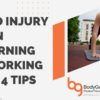The Rotator Cuff: What is it?
The true shoulder joint is where the shoulder blade (scapula) and the upper arm bone (humerus) meet. These ball and socket joints allow for the greatest range of motion over other types of joints. A rotator cuff is a group of four muscles that surround the joint to provide active stability and contribute to shoulder motions. These muscles can be torn from overuse or a traumatic injury, or their tendons can get impinged from inefficient movement mechanics.
Frozen Shoulder: Will I ever be able to move my shoulder again?
 Adhesive capsulitis is the formal name for frozen shoulder. It is a condition where the capsule surrounding the joint tightens and restrictions motion. With the capsule tightly wrapped around the shoulder joint, there isn’t enough space for the humerus to rotate normally.
Adhesive capsulitis is the formal name for frozen shoulder. It is a condition where the capsule surrounding the joint tightens and restrictions motion. With the capsule tightly wrapped around the shoulder joint, there isn’t enough space for the humerus to rotate normally.
Frozen shoulder often follows a period of inactivity, usually when people are afraid to move their shoulder after an injury or surgery. There are also various medical conditions that can contribute to the development of frozen shoulder, such as diabetes and thyroid problems. The exact mechanism that causes frozen shoulder though is still unknown.
Frozen shoulder usually follows three stages: freezing, frozen, and thawing. Everyone will eventually reach the thawing stage but it could take a year or longer. The goal of physical therapy is to attempt to speed up that timeline and make sure you can still do all the daily activities you need to do without putting your other joints at risk.
How can physical therapy help?
At Body Gears, we complete a thorough evaluation including examining how you sit, your joint range of motion, muscular strength, and mechanics of any movements you frequently perform, such as reaching and throwing. Physical therapists are able to perform a series of special tests to determine the source of your pain and diagnose which of the 4 rotator cuff muscles might be injured. Because they frequently contribute to symptoms, a screen of your cervical spine movement and neural mobility will also be completed.
We use many techniques and forms of treatment, including joint mobilizations, soft tissue manual therapy, Functional Dry Needling, muscle activation and strengthening exercises, and functional movement re-training. Our goal is to help you manage and eliminate pain, improve range of motion, increase muscle activation and strength, and restore efficient movement mechanics to get you back to normal function. Long-lasting relief from shoulder pain is on the way with the help of a physical therapist!
Request Free Consult or Contact Us Today at Chicago Lincoln Park, Oak Brook, Oak Park, & Winnetka, IL Centers to learn more about how we can help you get back to the things that matter most and enjoying life without pain.





